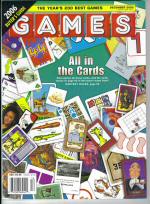*STAR
Designer: Ea Ea.
Players: 2. Playing Time: 1 hr.
Rules for a forerunner of this game, known simply as Star, appeared in this magazine way back in September 1983. The geometry of the board has changed since then, but the most important difference between the old Star and the new *Star involves the scoring system, as explained below. (More about the evolution of Star and other connection games can be found in the article, "Making Connections," June 2000 GAMES.)
 The pentagonal board has 276 hexagonal cells, including 50 along the perimeter where most of the scoring takes place. In the center is the unique Star space; this cannot be occupied but represents both players' colors, through which groups can connect. This clever rule neatly eliminates the problem of the central space providing an unfair advantage to its occupant.
The pentagonal board has 276 hexagonal cells, including 50 along the perimeter where most of the scoring takes place. In the center is the unique Star space; this cannot be occupied but represents both players' colors, through which groups can connect. This clever rule neatly eliminates the problem of the central space providing an unfair advantage to its occupant.
Players alternately place a marble of their color on a vacant space. Play ends when all spaces are filled or (with experienced players) when both contestants agree that no further useful plays are possible. Gain one point if you own three or more of the five corner spaces. For each connected group of two or more stones in your color, score one point for each perimeter space they occupy and one point for each vacant perimeter space they surround. If one player has more connected groups than the other, subtract the lower number of groups from the higher number. The player with fewer groups adds twice the difference to his score, and the opponent deducts this amount. (In the original Star, the amount added and subtracted was simply the difference in the number of groups, making connection of different groups only half as valuable.) The player with the higher score wins.
What makes this game so intriguing is the continuing dilemma that players face. Occupying perimeter spaces is a prerequisite to earning points, yet occupying central spaces is vital for connecting as many point-earning groups as possible. The player who is better able to balance these contradictory needs, as well as handle the often tricky tactics, will prevail.
The playing arena includes markings that define two smaller boards, which are recommended for beginners. Kadon adds extra value to the package (as usual) by providing useful strategy tips, as well as additional games and puzzles in the rules booklet.
—John J. McCallion

